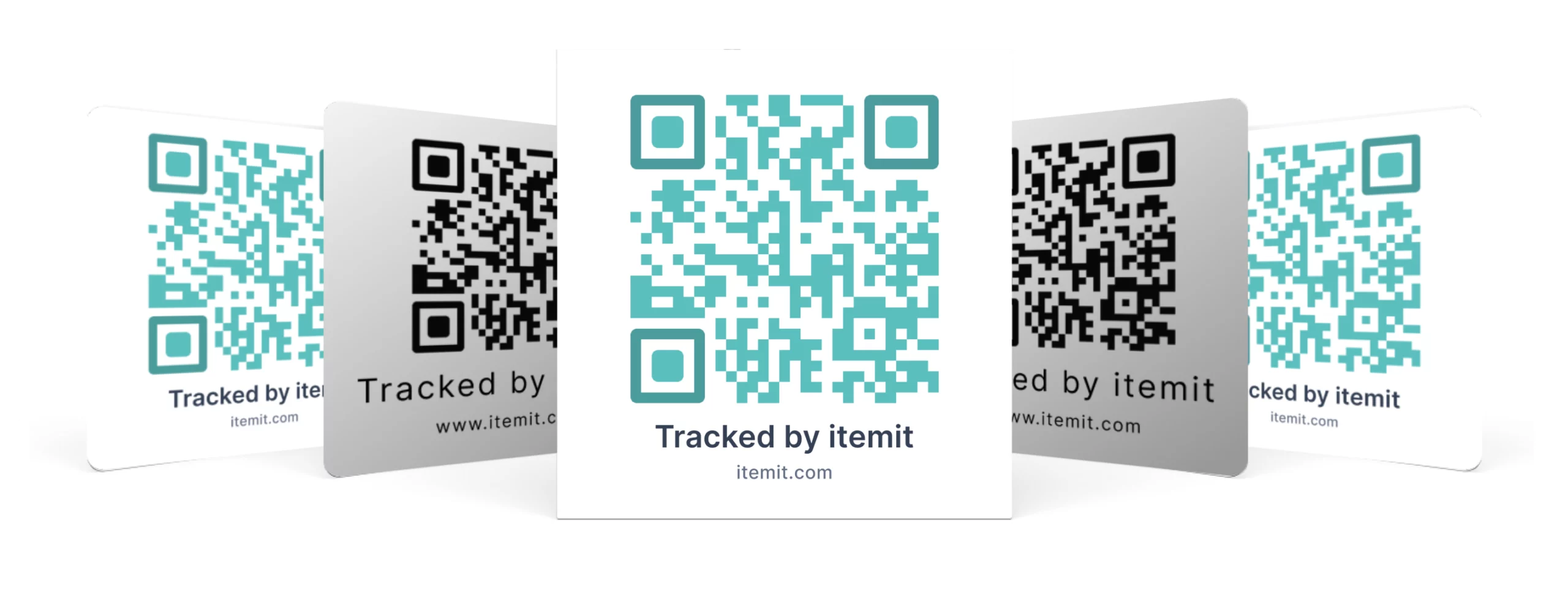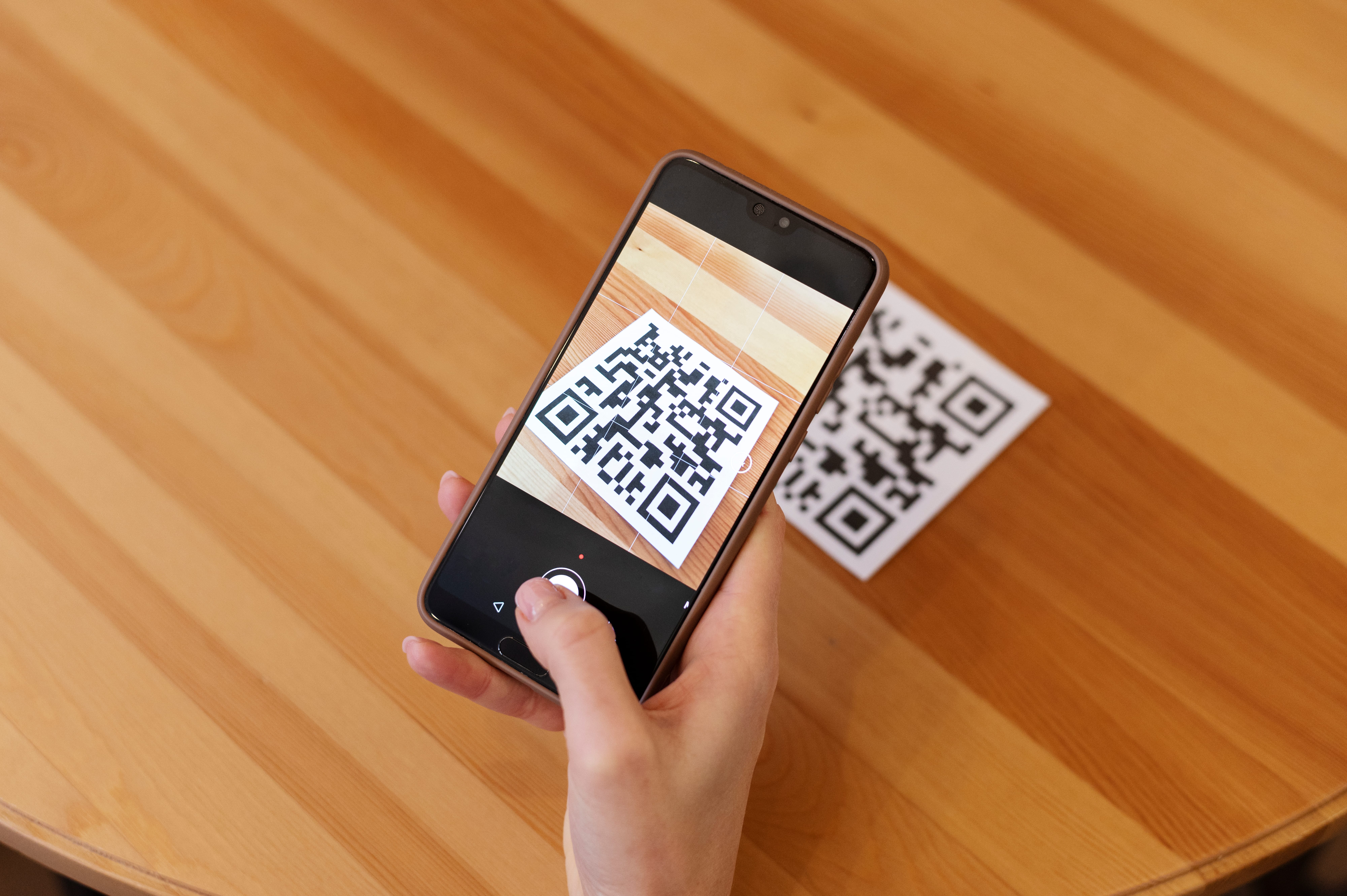
The QR tag has become a feature of modern life. They were to be found on brochures, flyers, and posters, and even on business cards that were connected directly to websites upon scanning. Actually, each one of us has our QR scanner in our pocket – a smartphone! Perhaps you’re aware that you can use QR code tags for tracking assets, but do you really understand exactly how they work and what they can do? Learn about everything QR code tags have to offer from this ultimate guide.
What is a QR Code?

A Quick Response Code, or a QR code as it is commonly referred to, is a two-dimensional barcode capable of storing information such as URLs, text, or contact details. It was developed in 1994 by Denso Wave, a Toyota subsidiary, for tracking parts in vehicle manufacturing. In the context of QR codes vs barcodes, they are different because they have a much higher storage capacity and can be read from any direction. It was the creator of the QR code, Masahiro Hara, who set out to develop a code that could be read quickly and reliably; the name is Quick Response.
A QR code is made up of black and white squares set on a grid – the structure of a QR code. These patterns involve information about the QR code intended to be read by a scanner, which will understand what is encoded in the matrix. A regular barcode normally holds data in only one dimension, but QR codes have the capability to do so in two dimensions, enabling them to store more complex information.
How Do QR Tags Work?
How do QR codes work, technically? When a camera scans a QR code tag, it captures the arrangement of black and white squares. Then, the scanner software processes this image to tell which modules represent data and which serve a functional purpose. Then, this data is extracted out and translated back into its original form, whether that be a URL, text, or another type of information.
The Use of QR Tags
QR tags are immensely popular nowadays, and their square-shaped barcodes make their way into each and every transaction. From retail and marketing to inventory management and asset tracking, the usage of QR asset tags has been voluminous. QR codes proved handy in containing the spread of COVID-19 during the recent pandemic by allowing contactless transactions and providing a lead for contact tracing.
QR code tags are helpful in asset management, as they could help keep track of items across various locations. Be it office equipment, manufacturing tools, or rental assets, QR tags help make sure that the assets are found with ease, monitored, and accounted for. When attached to a physical asset, the scanning of the tag opens up access to associated data, making asset management swift and easy.
There are lots of reasons to use QR codes in tracking your assets. From ease in creating to the less amount of equipment required to use them, they could be very simple in asset tracking systems. Let’s dive deeper into some advantages of QR code tags!
Benefits of QR Tags for Asset Tracking
Cheap and Simple Production
Because of their simplicity, QR code tags are cheap to produce, and because of their 2D nature, they are able to be printed onto a range of materials. In comparison with a standard barcode, a QR code is able to house more information in a much smaller space. This provides a discreet yet effective tracking solution that can easily be hidden out of sight on assets that have limited real estate space.
No Special Equipment Required
One of the great benefits about QR tags is that you do not have to invest one single cent in special equipment, just to be able to scan them. In fact, most smartphones, which exist today, have already been fitted with a camera and even the capability of scanning QR codes, both of which will definitely enable anyone to interact with a QR code tag. This is actually one of the primary reasons that QR code tags are so popular these days.
Easy Integration into Your Asset Management System
It’s fairly simple, actually, to create a QR code asset management system. Pretty much any inventory management and asset management software is designed to function with QR codes; you simply need a way of creating them. Once you have created your QR code tags, they can then be linked through your asset management software, which will provide a seamless way of tracking and managing your inventory.
Durable and Damage Resistant
One of the worst things that could happen to an asset tag would be when it has worn out and becomes unreadable. This may lead to serious delays and inefficiencies within a workforce. Fortunately, QR code tags are quite durable, and even if they are up to 30% damaged, with error correction technology, they can still remain scannable. Such resilience makes the QR tags ideal in places like construction sites or warehouses, where wear and tear are something mundane.
Versatility in Application
Another important advantage with QR code tags is their adaptability. This tag can be attached to almost any surface: plastic, metal, wood, and even fabric. They can be printed in the form of stickers, embedded on metal, and embedded into labels. This flexibility of QR tags makes them suitable for an enormous array of industries: healthcare, manufacturing, education, and logistics.

QR Code Technology and Standards
The technology supporting QR code tags depends upon a set of standards, all of which ensure that there is uniformity reliably across many ways. The QR code standard regulates how QR codes should be formatted, generated, and scanned. The standards developed by ISO mean that QR codes can be utilised universally without problems in compatibility.
The structure is further subdivided into sections, each serving a particular purpose of the QR code. For example, the Finder Pattern, located at three corners of the code, helps the scanners in locating and orienting the QR code. The timing pattern helps determine the data module grid, while the alignment pattern helps correct the distortion when the code is read at an angle. These structural features enable the immediate and accurate scanning of QR codes, a very important aspect of their effectiveness in tracking assets and other uses.
Types of QR Tags for Asset Tracking
Not all QR code tags are created equal. There are different types of QR tags available, depending on the intended use and environment. The most common types include:
- Vinyl QR Code Stickers: These are the most basic and economical type of QR tags. They are suitable for indoor environments and can be easily affixed to most surfaces.
- Anodised Aluminium QR Tags: These are designed for durability and are ideal for harsh environments. The anodised aluminium ensures the QR tag is weather-resistant, making it perfect for outdoor use or in conditions where the tag may be exposed to chemicals or abrasion.
- Embedded QR Code Labels: These tags are embedded directly into the product or asset during manufacturing. They are highly durable and tamper-proof, making them ideal for high-value or sensitive assets.
How to Create QR Code Tags for Asset Management
Creating QR code tags for asset management is a straightforward process. You can use online QR code generators to produce the code, which can then be printed on a variety of materials depending on your needs. Here’s a step-by-step guide to creating your QR tags:
- Choose an Online QR Code Generator: There are many online tools available that allow you to create QR codes for free or for a nominal fee. Make sure to choose a generator that allows you to download high-resolution codes suitable for printing.
- Input the Data You Want to Encode: This could be a URL linking to your asset management system, text, or any other relevant information.
- Customise the QR Code: Some QR generators allow you to customise the code’s colour, add logos, or even create dynamic QR codes that can be updated after printing.
- Download and Print the QR Code: Once generated, download the QR code in the desired format (such as PNG or SVG) and print it on your chosen material—vinyl, aluminium, or standard label paper.
- Attach the QR Code Tag to Your Asset: Ensure the tag is affixed securely to the asset in a location that is easily accessible for scanning.
Tips for Using QR Code Tags Effectively
To get the most out of your QR code tags for asset tracking, follow these best practices:
- Ensure Proper Placement: Attach the QR code tag in a location that is easily accessible for scanning. Avoid areas prone to dirt or damage, which may affect the code’s readability.
- Use High-Quality Materials: If your assets are used in harsh conditions, opt for durable materials like anodised aluminium to ensure the tags last longer.
- Regularly Update QR Code Information: If your QR code tags are linked to dynamic data, make sure the information is updated regularly. This will ensure that users have access to the most current asset details.
- Test Before Implementation: Test the readability of your QR code tags using different devices before rolling them out on a large scale. This helps identify potential issues early and ensures smooth scanning in the field.
QR Tags in Different Industries

QR tags have applications across a wide range of industries. Now, let’s try exploring how different sectors are using QR tags to automate their system for smooth functioning:
Healthcare
QR code tags are able to track medical equipment, patient records, and pharmaceuticals in the healthcare industry. Attaching QR tags to medical devices allows hospitals to assure timely maintenance and proper accounting of their equipment. QR code tags can be used on patient wristbands so that health professionals have immediate access to patient information, reducing the possibility of errors and improving patient care.
Manufacturing
These QR code tags are applied to manufacturing for raw materials tracking, work-in-progress items, and finished products. This can be used by the manufacturer in monitoring the material as it moves through the production process, ensuring accountability for each component and adherence to production schedules. QR tags can also be used in quality control, whereby an inspector scans the product for detailed information about each item.
Retail
QR code tags for inventory management, product information, and customer contact. QR tags will be affixed to merchandise for scanning by customers for extended information such as product specifications, product reviews, or promotions. Retailers will use QR tags in streamlining the efficiency of inventory management whereby staff can quickly scan and update the stock level of an item.
Logistics and Supply Chain
QR code tags are used for logistic supply and chain management purposes in tracking shipments, inventory levels, and warehouse operations. QR tags ensure that products are correctly tracked as they make their way along the supply chain, minimising losses from loss or misplacement. They further allow insight into real-time inventory visibility for informed decisions on the replenishment of stock.
Education
Educational institutions are also using QR code tags to improve the learning experience and further facilitate asset management effectively. QR tags can be used in libraries to inventory books and other resources for easy tracking among students and staff. QR codes in classrooms can grant students access to digital content like videos, quizzes, or extra reading by scanning the code with their smartphones.
Common Challenges with QR Code Tags and How to Overcome Them

While QR code tags have several advantages, there are two or so challenges that come along with using them. Here are some common challenges and some tips regarding how to overcome them:
Damage and Wear of Tags
QR code tags can also get destroyed due to time, particularly in unfit conditions. The type of tag material should be correct according to the environment it will be used for, in this case. For example, anodised aluminium tags last longer and so can support extreme weather conditions and so is apt for outdoors or harsh industrial usage.
Poor Placement
Poor positioning of QR code tags renders them cumbersome to scan. The tags should be placed in positions that are easy to access and which would not get easily destroyed or blocked. For instance, it is best to avoid placing a tag on an object that could be buried by items or covered with dust, dirt, or grime during its lifetime.
Poor Printing
Poor quality printing also leads to QR code tags that can’t be scanned. Due to this fact, high-resolution printing should be used in order to present a clear and readable QR code. Also, the use of contrast between the code and the background will enhance the efficiency of scanning.
Lack of User Training
Unless the user is familiar with scanning QR code tags or accessing information they carry, full benefits of QR tagging may not be realised. Training and clear instructions in using the QR codes go a long way in making all users comfortable using the technology and exploit it for their benefit.
Security Considerations for QR Code Tags
While QR code tags are easy to use and versatile, it is important to take security into account when using QR code tags for the tracking of assets. Here are a few security tips you might want to consider:
Use Secure URLs
If your QR code tags link to something online, make sure the URL is secure; in other words, they should use HTTPS so that sensitive information will not be intercepted by unauthorised parties. Limit access to sensitive information.
Limit Access to Sensitive Information
Not all information should be available to anyone who can scan a QR code tag. Sensitive asset information should be protected using authentication or password protection so that it is only provided to those with access to that level. Only authorised personnel should have access to and/or update the asset information.
Monitor and Track Scans
Knowing the number and location of scans can already locate potential areas of where it could have been breached. Many asset management systems have tracking features that enable you to monitor when and where QR code tags are scanned, adding another layer of security.
Future Trends in QR Code Technology

While QR code technology is still evolving, some of the trends one may soon observe are the combination of blockchain with QR codes to ensure secure and tamper-proof asset tracking. This would be a very useful service for cases with high-value assets or supply chain management where data integrity is of utmost importance.
Another emerging trend is the usage of QR code tags within AR. For example, consider scanning a QR code on an asset and receiving a 3D visual in return on how to operate or repair the asset. This kind of innovation could very well totally revamp training and maintenance practices across industries.
Last but not least, there is an emerging trend toward what is called dynamic QR codes that can be edited after they have actually been printed. That grants an enterprise an opportunity to change the information encoded in the QR tag without having to replace the actual physical tag, hence providing better and less expensive management of its possessions.
itemit’s QR Tags
Therefore, a QR code tag is a very powerful tool for tracking any asset effectively, efficiently, and economically, including various models for different applications. From ease of production to durability and integration with other system components, the QR tag has proved invaluable in scores of diverse industries. Be it managing office equipment, rental assets, or high-value tools, QR code tags offer a modern solution that makes it easier than ever to track and manage your assets.
Here at itemit, we have various kinds of QR code tags intended for different asset management needs. Vinyl QR code stickers are great economically for managing tags indoors. Anodised aluminium tags will serve users who want more strength. These robust tags will resist extreme temperatures, harsh chemicals, and physical abrasion, hence suitable for outdoor applications or industrial sites.
Our QR tags range in size from 15 to 50 millimetres, so you’ll be able to make a good choice depending on the asset concerned. Whether you need a tag discreetly placed on something small or something a little larger for heavy machinery, itemit has you sorted.
If you would like to learn more about how itemit’s QR code tags can help streamline the process of tracking your assets efficiently, please contact our team at team@itemit.com. Alternatively, fill in the form below to start your very own 14-day free trial.

Try itemit
Choose a better way to track
your assets.
Start your free 14-day trial now!

Keep Learning
itemit Blog
Tips, guides, industry best practices, and news.
Track Your Agricultural Assets With RFID Tags
Discover how RFID technology enhances agriculture management with better inventory tracking, livestock monitoring, and operational efficiency, even for small farms.
Which Is Better? RFID Tags Or Barcodes?
Is RFID asset tracking better than using barcodes or is it vice versa? Read this post now to discover which option is ideal for you!
The Future Of Asset Tracking Involves RFID Tags: Here’s Why
Find out exactly why the future of asset tracking in the workplace involves RFID asset tracking by reading this article now!


